Metabolomic Profiling of Heat Tolerance During Grain Filling in Rice: Comparative Analyses of Panicles and Roots in ‘Fusaotome’ and ‘Akitakomachi’
Abstract
1. Introduction
2. Materials and Methods
2.1. Plant Materials and Cultivation
2.2. Experimental Treatments
2.3. Sampling
2.4. Metabolomic Analysis
2.5. Data Analysis
3. Results
3.1. Temperature Conditions in Treatments
3.2. Effects of High Temperature on Metabolite Profiles in Panicles and Roots
3.3. Metabolite-Level Responses to High Temperature
3.4. Amino Acid Correlation Network to High Temperature
3.5. Pathway-Level Responses to High Temperature
4. Discussion
4.1. Metabolite-Level Responses to High Temperature
4.2. Amino Acid Correlation Network to High Temperature
4.3. Pathway-Level Responses to High Temperature
5. Conclusions
Supplementary Materials
Author Contributions
Funding
Institutional Review Board Statement
Data Availability Statement
Conflicts of Interest
Abbreviations
| ROS | Reactive oxygen species |
| SOD | Superoxide dismutase |
| POD | Peroxidase |
| GSSG | Oxidized glutathione |
References
- Jagadish, S.; Murty, M.; Quick, W. Rice responses to rising temperatures–challenges, perspectives and future directions. Plant Cell Environ. 2015, 38, 1686–1698. [Google Scholar] [CrossRef]
- Prasad, P.; Boote, K.; Allen, L., Jr.; Sheehy, J.; Thomas, J. Species, ecotype and cultivar differences in spikelet fertility and harvest index of rice in response to high temperature stress. Field Crops Res. 2006, 95, 398–411. [Google Scholar] [CrossRef]
- Ishigooka, Y.; Kuwagata, T.; Nishimori, M.; Hasegawa, T.; Ohno, H. Spatial characterization of recent hot summers in Japan with agro-climatic indices related to rice production. J. Agric. Meteorol. 2011, 67, 209–224. [Google Scholar] [CrossRef]
- Morita, S.; Wada, H.; Matsue, Y. Countermeasures for heat damage in rice grain quality under climate change. Plant Prod. Sci. 2016, 19, 1–11. [Google Scholar] [CrossRef]
- Tashiro, T.; Wardlaw, I.F. The effect of high temperature at different stages of ripening on grain set, grain weight and grain dimensions in the semi-dwarf wheat ‘Banks’. Ann. Bot. 1990, 65, 51–61. [Google Scholar] [CrossRef]
- Yamakawa, H.; Hakata, M. Atlas of rice grain filling-related metabolism under high temperature: Joint analysis of metabolome and transcriptome demonstrated inhibition of starch accumulation and induction of amino acid accumulation. Plant Cell Physiol. 2010, 51, 795–809. [Google Scholar] [CrossRef]
- Shi, W.; Muthurajan, R.; Rahman, H.; Selvam, J.; Peng, S.; Zou, Y.; Jagadish, K.S. Source–sink dynamics and proteomic reprogramming under elevated night temperature and their impact on rice yield and grain quality. New Phytol. 2013, 197, 825–837. [Google Scholar] [CrossRef] [PubMed]
- Liao, J.-L.; Zhou, H.-W.; Zhang, H.-Y.; Zhong, P.-A.; Huang, Y.-J. Comparative proteomic analysis of differentially expressed proteins in the early milky stage of rice grains during high temperature stress. J. Exp. Bot. 2014, 65, 655–671. [Google Scholar] [CrossRef]
- Mitsui, T.; Yamakawa, H.; Kobata, T. Molecular physiological aspects of chalking mechanism in rice grains under high-temperature stress. Plant Prod. Sci. 2016, 19, 22–29. [Google Scholar] [CrossRef]
- Foyer, C.H.; Noctor, G. Redox homeostasis and antioxidant signaling: A metabolic interface between stress perception and physiological responses. Plant Cell 2005, 17, 1866–1875. [Google Scholar] [CrossRef]
- Mei, W.; Chen, W.; Wang, Y.; Liu, Z.; Dong, Y.; Zhang, G.; Deng, H.; Liu, X.; Lu, X.; Wang, F. Exogenous kinetin modulates ROS homeostasis to affect heat tolerance in rice seedlings. Int. J. Mol. Sci. 2023, 24, 6252. [Google Scholar] [CrossRef]
- Mthiyane, P.; Aycan, M.; Mitsui, T. Strategic advancements in rice cultivation: Combating heat stress through genetic innovation and sustainable practices—A review. Stresses 2024, 4, 452–480. [Google Scholar] [CrossRef]
- Arai-Sanoh, Y.; Ishimaru, T.; Ohsumi, A.; Kondo, M. Effects of soil temperature on growth and root function in rice. Plant Prod. Sci. 2010, 13, 235–242. [Google Scholar] [CrossRef]
- Zhen, B.; Li, H.; Niu, Q.; Qiu, H.; Tian, G.; Lu, H.; Zhou, X. Effects of combined high temperature and waterlogging stress at booting stage on root anatomy of rice (Oryza sativa L.). Water 2020, 12, 2524. [Google Scholar] [CrossRef]
- Soga, T.; Ohashi, Y.; Ueno, Y.; Naraoka, H.; Tomita, M.; Nishioka, T. Quantitative metabolome analysis using capillary electrophoresis mass spectrometry. J. Proteome Res. 2003, 2, 488–494. [Google Scholar] [CrossRef] [PubMed]
- Pang, Z.; Lu, Y.; Zhou, G.; Hui, F.; Xu, L.; Viau, C.; Spigelman, A.F.; MacDonald, P.E.; Wishart, D.S.; Li, S. MetaboAnalyst 6.0: Towards a unified platform for metabolomics data processing, analysis and interpretation. Nucleic Acids Res. 2024, 52, W398–W406. [Google Scholar] [CrossRef]
- Zhang, S.; Wang, S.; Wang, S.; Su, H.; De, J. Genetic Diversity and Metabolic Profile of Tibetan Medicinal Plant Saussurea obvallata. Genes 2025, 16, 593. [Google Scholar] [CrossRef]
- Chen, D.; Shao, Q.; Yin, L.; Younis, A.; Zheng, B. Polyamine function in plants: Metabolism, regulation on development, and roles in abiotic stress responses. Front. Plant Sci. 2019, 9, 1945. [Google Scholar] [CrossRef]
- Kusano, T.; Berberich, T.; Tateda, C.; Takahashi, Y. Polyamines: Essential factors for growth and survival. Planta 2008, 228, 367–381. [Google Scholar] [CrossRef] [PubMed]
- Fu, Y.; Gu, Q.; Dong, Q.; Zhang, Z.; Lin, C.; Hu, W.; Pan, R.; Guan, Y.; Hu, J. Spermidine enhances heat tolerance of rice seeds by modulating endogenous starch and polyamine metabolism. Molecules 2019, 24, 1395. [Google Scholar] [CrossRef] [PubMed]
- Tang, S.; Zhang, H.; Li, L.; Liu, X.; Chen, L.; Chen, W.; Ding, Y. Exogenous spermidine enhances the photosynthetic and antioxidant capacity of rice under heat stress during early grain-filling period. Funct. Plant Biol. 2018, 45, 911–921. [Google Scholar] [CrossRef]
- Zhou, R.; Hu, Q.; Pu, Q.; Chen, M.; Zhu, X.; Gao, C.; Zhou, G.; Liu, L.; Wang, Z.; Yang, J. Spermidine enhanced free polyamine levels and expression of polyamine biosynthesis enzyme gene in rice spikelets under heat tolerance before heading. Sci. Rep. 2020, 10, 8976. [Google Scholar] [CrossRef]
- Noctor, G.; Mhamdi, A.; Chaouch, S.; Han, Y.; Neukermans, J.; Marquez-Garcia, B.; Queval, G.; Foyer, C.H. Glutathione in plants: An integrated overview. Plant Cell Environ. 2012, 35, 454–484. [Google Scholar] [CrossRef]
- Kavi Kishor, P.B.; Suravajhala, P.; Rathnagiri, P.; Sreenivasulu, N. Intriguing role of proline in redox potential conferring high temperature stress tolerance. Front. Plant Sci. 2022, 13, 867531. [Google Scholar] [CrossRef]
- Renzetti, M.; Funck, D.; Trovato, M. Proline and ROS: A unified mechanism in plant development and stress response? Plants 2024, 14, 2. [Google Scholar] [CrossRef] [PubMed]
- Guo, M.; Zhang, X.; Liu, J.; Hou, L.; Liu, H.; Zhao, X. OsProDH negatively regulates thermotolerance in rice by modulating proline metabolism and reactive oxygen species scavenging. Rice 2020, 13, 61. [Google Scholar] [CrossRef]
- Francioso, A.; Baseggio Conrado, A.; Mosca, L.; Fontana, M. Chemistry and biochemistry of sulfur natural compounds: Key intermediates of metabolism and redox biology. Oxidative Med. Cell. Longev. 2020, 2020, 8294158. [Google Scholar] [CrossRef] [PubMed]
- Ashraf, M.; Foolad, M. Roles of glycine betaine and proline in improving plant abiotic stress resistance. Environ. Exp. Bot. 2007, 59, 206–216. [Google Scholar] [CrossRef]
- Gill, S.S.; Tuteja, N. Polyamines and abiotic stress tolerance in plants. Plant Signal. Behav. 2010, 5, 26–33. [Google Scholar] [CrossRef]
- Masclaux-Daubresse, C.; Daniel-Vedele, F.; Dechorgnat, J.; Chardon, F.; Gaufichon, L.; Suzuki, A. Nitrogen uptake, assimilation and remobilization in plants: Challenges for sustainable and productive agriculture. Ann. Bot. 2010, 105, 1141–1157. [Google Scholar] [CrossRef]
- Arnao, M.B.; Hernández-Ruiz, J. Melatonin: A new plant hormone and/or a plant master regulator? Trends Plant Sci. 2019, 24, 38–48. [Google Scholar] [CrossRef] [PubMed]
- Zhao, D.; Yu, Y.; Shen, Y.; Liu, Q.; Zhao, Z.; Sharma, R.; Reiter, R.J. Melatonin synthesis and function: Evolutionary history in animals and plants. Front. Endocrinol. 2019, 10, 441357. [Google Scholar] [CrossRef] [PubMed]
- Sipari, N.; Lihavainen, J.; Keinänen, M. Metabolite Profiling of Paraquat Tolerant Arabidopsis thaliana Radical-induced Cell Death1 (rcd1)—A Mediator of Antioxidant Defence Mechanisms. Antioxidants 2022, 11, 2034. [Google Scholar] [CrossRef]
- El-Azaz, J.; Moore, B.; Takeda-Kimura, Y.; Yokoyama, R.; Wijesingha Ahchige, M.; Chen, X.; Schneider, M.; Maeda, H.A. Coordinated regulation of the entry and exit steps of aromatic amino acid biosynthesis supports the dual lignin pathway in grasses. Nat. Commun. 2023, 14, 7242. [Google Scholar] [CrossRef]
- Ingrisano, R.; Tosato, E.; Trost, P.; Gurrieri, L.; Sparla, F. Proline, cysteine and branched-chain amino acids in abiotic stress response of land plants and microalgae. Plants 2023, 12, 3410. [Google Scholar] [CrossRef]
- Kishor, P.K.; Suravajhala, R.; Rajasheker, G.; Marka, N.; Shridhar, K.K.; Dhulala, D.; Scinthia, K.P.; Divya, K.; Doma, M.; Edupuganti, S. Lysine, lysine-rich, serine, and serine-rich proteins: Link between metabolism, development, and abiotic stress tolerance and the role of ncRNAs in their regulation. Front. Plant Sci. 2020, 11, 546213. [Google Scholar] [CrossRef]
- Tang, S.; Xian, Y.; Wang, F.; Luo, C.; Song, W.; Xie, S.; Chen, X.; Cao, A.; Li, H.; Liu, H. Comparative transcriptome analysis of leaves during early stages of chilling stress in two different chilling-tolerant brown-fiber cotton cultivars. PLoS ONE 2021, 16, e0246801. [Google Scholar] [CrossRef]
- Yang, X.; Kwon, H.; Kim, M.Y.; Lee, S.-H. RNA-seq profiling in leaf tissues of two soybean (Glycine max [L.] Merr.) cultivars that show contrasting responses to drought stress during early developmental stages. Mol. Breed. 2023, 43, 42. [Google Scholar] [CrossRef] [PubMed]
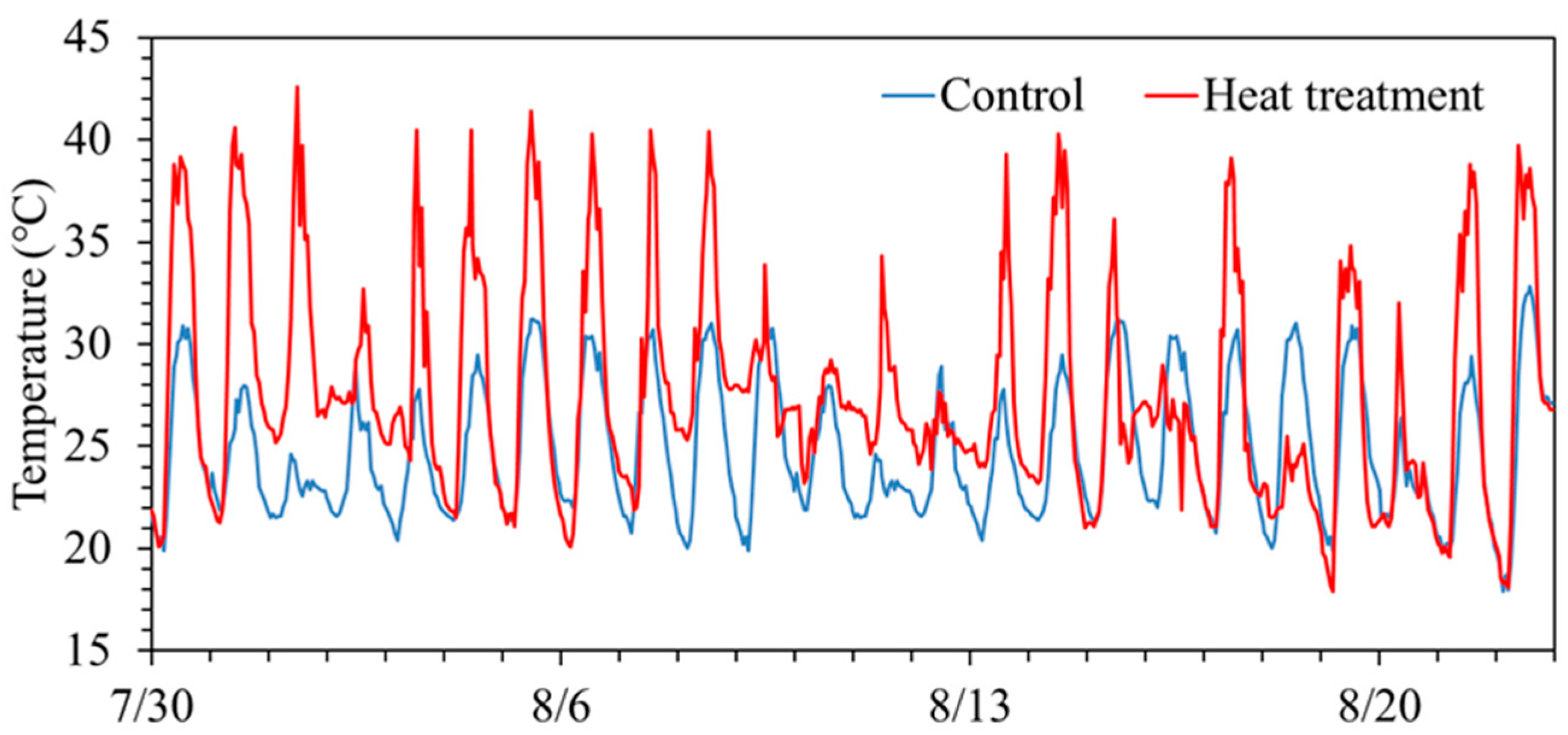
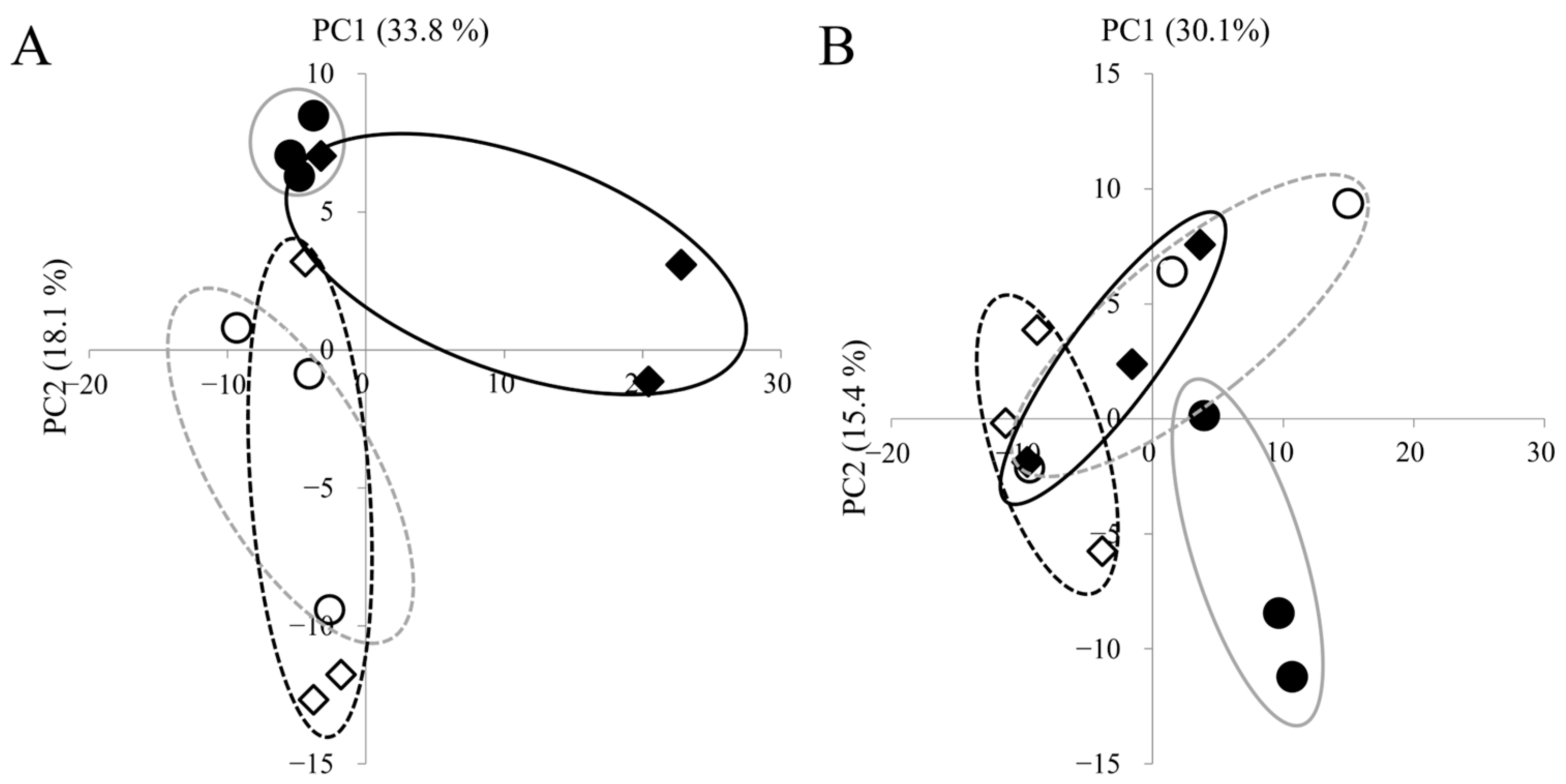

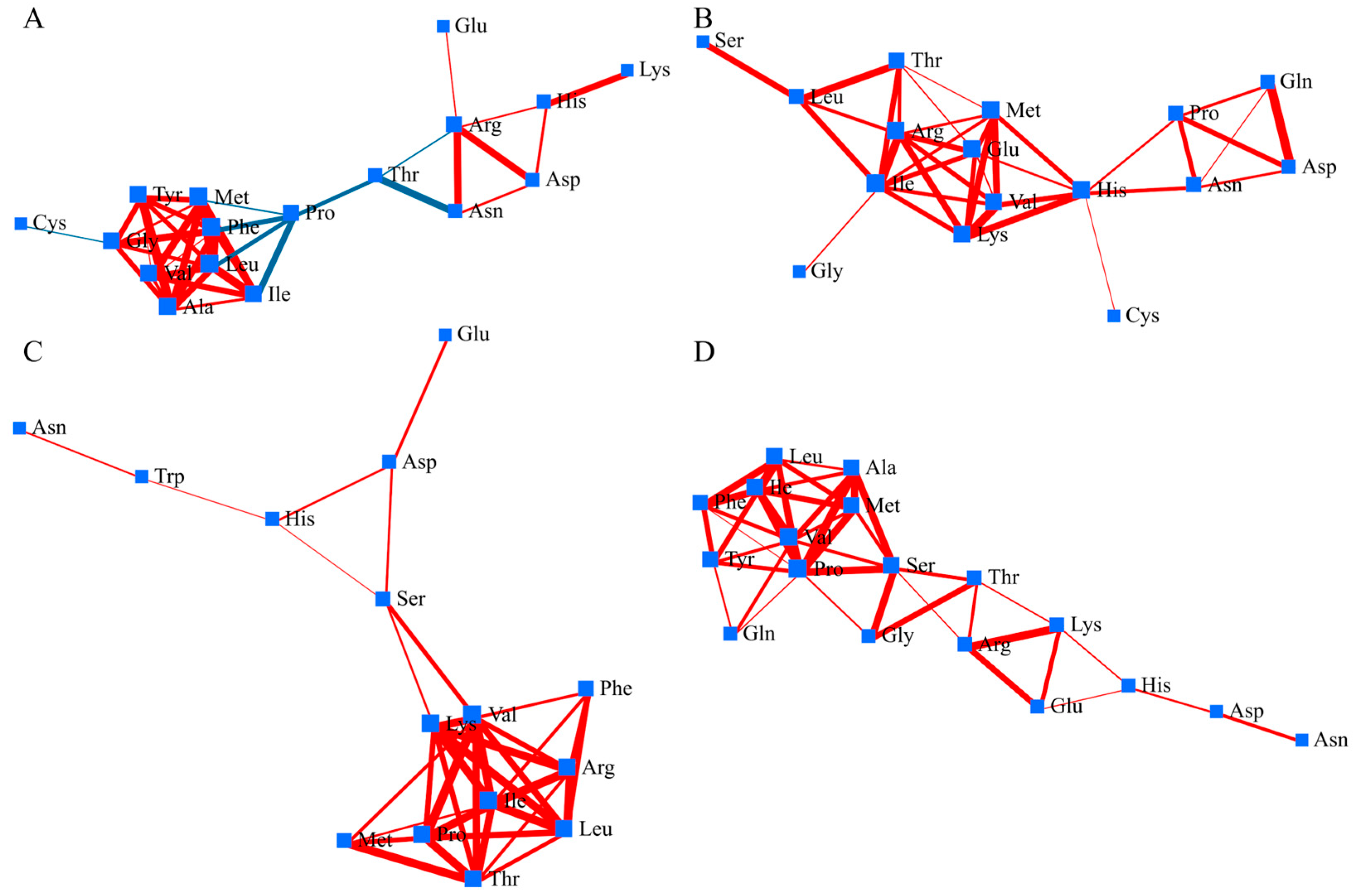
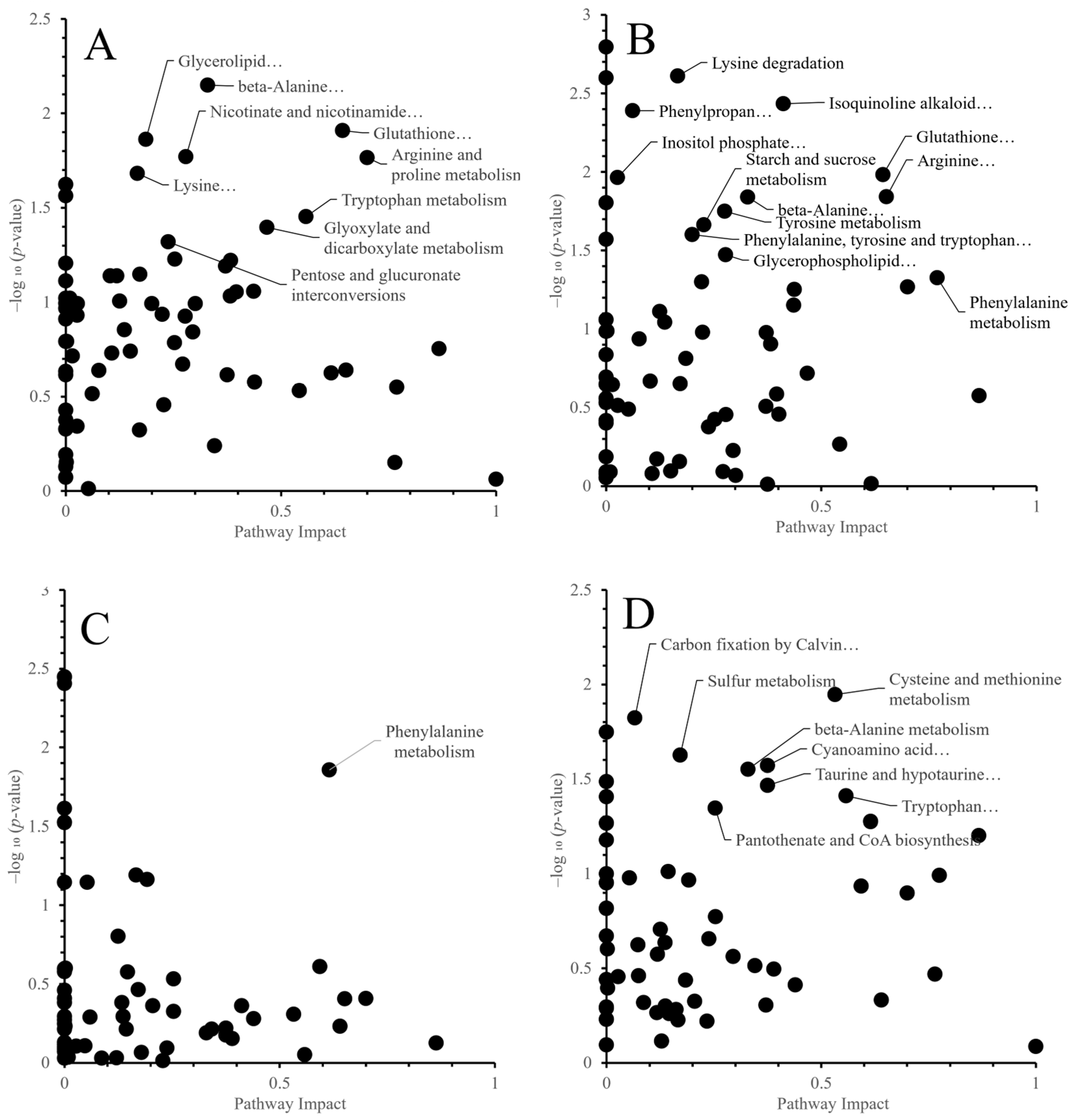
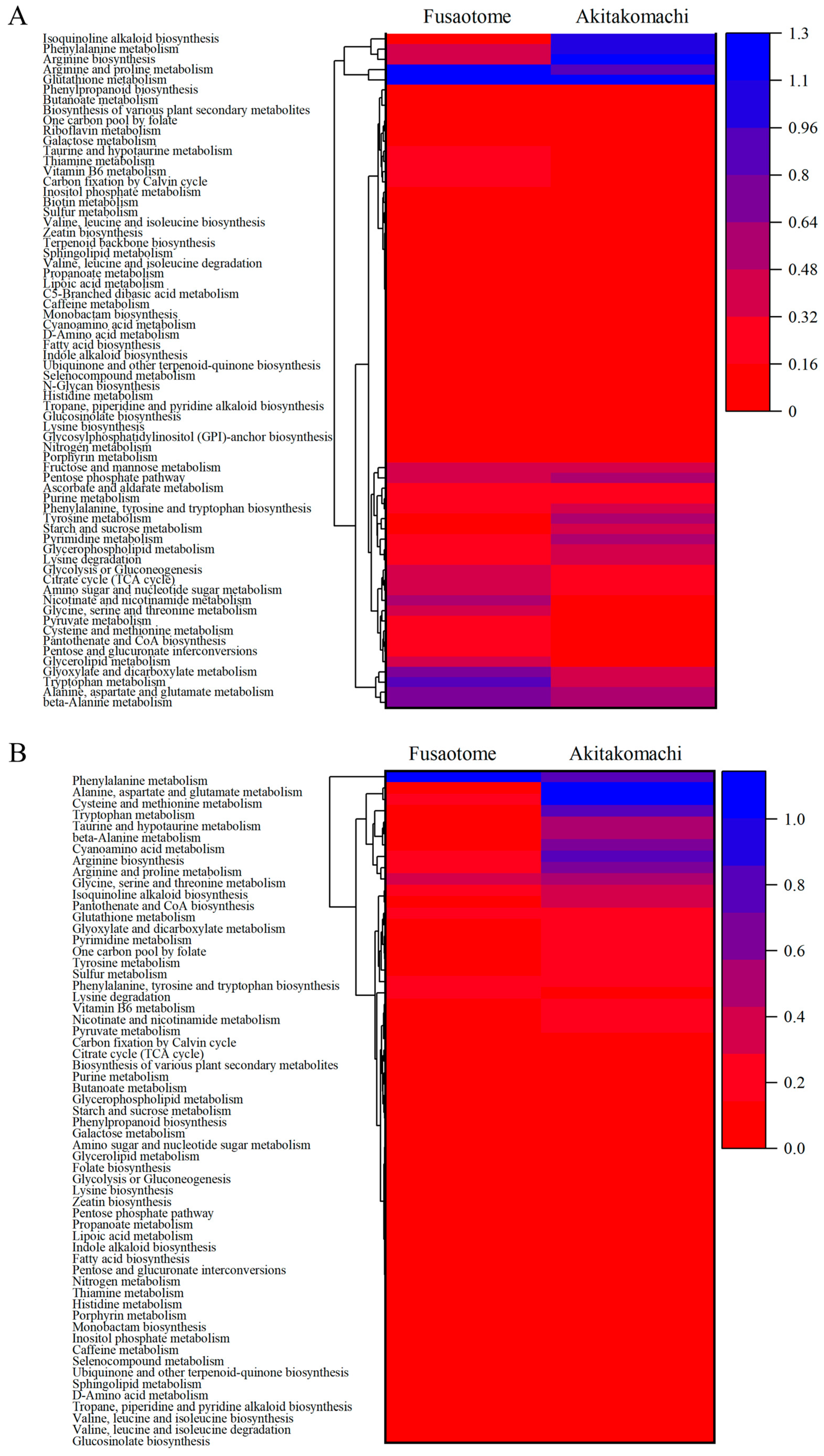
| Control (°C) | Heat Treatment (°C) | Temperature Difference (°C) | ||
|---|---|---|---|---|
| Fusaotome | Day time | 26.7 | 30.5 | 3.8 |
| Night tine | 22.1 | 24.8 | 2.7 | |
| Aktakomachi | Day time | 26.5 | 31.8 | 5.3 |
| Night tine | 22.3 | 24.6 | 2.3 |
| Fusaotome | Akitakomachi | ||||
|---|---|---|---|---|---|
| Substances | Heat/Control | p-Value | Substances | Heat/Control | p-Value |
| Increase | |||||
| Triethanolamine | 5.72 | 0.012 | Ornithine | 7.13 | 0.010 |
| Spermidine | 2.10 | 0.003 | Pyroglutamine | 6.10 | 0.028 |
| N-Acetylalanine | 1.81 | 0.025 | Anthranilic acid | 4.81 | 0.045 |
| Alloisoleucine | 1.71 | 0.015 | N-(1-Deoxy-1-fructosyl)valine | 2.72 | 0.031 |
| Glutamic acid gamma-methyl ester | 1.71 | 0.003 | Lys | 1.98 | 0.045 |
| Val | 1.68 | 0.035 | N6-Methyllysine | 1.93 | 0.008 |
| 2-Methylserine | 1.65 | 0.003 | Spermidine | 1.92 | 0.011 |
| Citric acid | 1.59 | 0.032 | Theobromine | 1.82 | 0.004 |
| Oxalic acid | 1.78 | 0.006 | |||
| Citrulline | 1.77 | 0.013 | |||
| Saccharopine | 1.67 | 0.021 | |||
| Arg | 1.63 | 0.033 | |||
| Asn | 1.59 | 0.027 | |||
| Sinapic acid | 1.58 | 0.037 | |||
| Dimethylaminoethanol | 1.58 | 0.040 | |||
| N-Acetylornithine | 1.56 | 0.027 | |||
| Gln | 1.56 | 0.001 | |||
| Nω-Methylarginine | 1.56 | 0.006 | |||
| Isocitric acid | 1.52 | 0.033 | |||
| Decrease | |||||
| Thiamine phosphate | 0.19 | 0.020 | Cadaverine | 0.10 | 0.003 |
| Serotonin | 0.30 | 0.007 | γ-Glu-Cys | 0.21 | 0.040 |
| Threonic acid | 0.50 | 0.006 | Quinic acid | 0.50 | 0.040 |
| 2-Deoxyribonic acid | 0.54 | 0.003 | Shikimic acid | 0.53 | 0.015 |
| Glyceric acid | 0.55 | 0.004 | Sedoheptulose 7-phosphate | 0.53 | 0.024 |
| AMP | 0.59 | 0.040 | Galacturonic acid | 0.54 | 0.024 |
| Phosphoenolpyruvic acid | 0.61 | 0.023 | |||
| 3-Phosphoglyceric acid | 0.63 | 0.029 | |||
| Tyrosine methyl ester | 0.64 | 0.012 | |||
| Ribulose 5-phosphate | 0.65 | 0.007 | |||
| Ascorbate 2-glucoside | 0.66 | 0.047 | |||
| Fusaotome | Akitakomachi | ||||
|---|---|---|---|---|---|
| Substances | Heat/Control | p-Value | Substances | Heat/Control | p-Value |
| Increase | |||||
| Lys | 1.88 | 0.031 | Glucuronic acid | 4.69 | 0.025 |
| Arg | 1.86 | 0.028 | Ile-Pro-Pro | 4.51 | 0.036 |
| Met | 1.80 | 0.038 | Thiaproline | 3.87 | 0.020 |
| Val | 1.78 | 0.003 | 2-Methylthiazolidine-4-carboxylic acid | 2.96 | 0.026 |
| Leu | 1.76 | 0.012 | Uric acid | 2.81 | 0.011 |
| γ-Glu-Phe | 1.76 | 0.027 | Cysteine glutathione disulfide | 2.59 | 0.043 |
| Ile | 1.73 | 0.006 | N-Acetylgalactosamine | 2.05 | 0.028 |
| γ-Glu-Ile γ-Glu-Leu | 1.72 | 0.036 | N-Acetyllysine | 1.99 | 0.027 |
| Phe | 1.72 | 0.023 | Oxalic acid | 1.61 | 0.011 |
| Pro | 1.71 | 0.001 | |||
| γ-Glu-Val | 1.64 | 0.006 | |||
| Thr | 1.51 | 0.013 | |||
| Fusaotome | Akitakomachi | ||||||
|---|---|---|---|---|---|---|---|
| Pathway | Pathway Impact | –log10 (p-Value) | Score | Pathway Impact | –log10 (p-Value) | Score | Score Difference |
| Tryptophan metabolism | 0.56 | 1.45 | 0.81 | 0.37 | 0.98 | 0.36 | 0.45 |
| Glycine, serine and threonine metabolism | 0.62 | 0.62 | 0.39 | 0.62 | 0.02 | 0.01 | 0.38 |
| Nicotinate and nicotinamide metabolism | 0.28 | 1.77 | 0.49 | 0.28 | 0.46 | 0.13 | 0.37 |
| Arginine and proline metabolism | 0.70 | 1.77 | 1.24 | 0.70 | 1.27 | 0.89 | 0.35 |
| Glyoxylate and dicarboxylate metabolism | 0.47 | 1.40 | 0.65 | 0.47 | 0.72 | 0.34 | 0.32 |
| Amino sugar and nucleotide sugar metabolism | 0.38 | 1.22 | 0.47 | 0.40 | 0.46 | 0.18 | 0.28 |
| Pyruvate metabolism | 0.30 | 0.99 | 0.30 | 0.30 | 0.07 | 0.02 | 0.28 |
| Citrate cycle (TCA cycle) | 0.37 | 1.19 | 0.44 | 0.37 | 0.51 | 0.19 | 0.25 |
| Taurine and hypotaurine metabolism | 0.38 | 0.61 | 0.23 | 0.38 | 0.01 | 0.00 | 0.23 |
| Pentose and glucuronate interconversions | 0.24 | 1.32 | 0.31 | 0.24 | 0.38 | 0.09 | 0.22 |
| Pantothenate and CoA biosynthesis | 0.25 | 1.23 | 0.31 | 0.25 | 0.43 | 0.11 | 0.20 |
| Glycerolipid metabolism | 0.19 | 1.86 | 0.35 | 0.19 | 0.81 | 0.15 | 0.20 |
| Glycolysis or Gluconeogenesis | 0.40 | 1.05 | 0.42 | 0.40 | 0.59 | 0.23 | 0.19 |
| Vitamin B6 metabolism | 0.30 | 0.84 | 0.25 | 0.30 | 0.23 | 0.07 | 0.18 |
| Thiamine metabolism | 0.27 | 0.67 | 0.18 | 0.27 | 0.09 | 0.02 | 0.16 |
| Alanine, aspartate and glutamate metabolism | 0.87 | 0.75 | 0.65 | 0.87 | 0.58 | 0.50 | 0.15 |
| Cysteine and methionine metabolism | 0.54 | 0.53 | 0.29 | 0.54 | 0.27 | 0.14 | 0.14 |
| Riboflavin metabolism | 0.12 | 1.14 | 0.13 | 0.12 | 0.17 | 0.02 | 0.11 |
| beta-Alanine metabolism | 0.33 | 2.15 | 0.71 | 0.33 | 1.84 | 0.61 | 0.10 |
| One carbon pool by folate | 0.15 | 0.74 | 0.11 | 0.15 | 0.10 | 0.01 | 0.10 |
| Fusaotome | Akitakomachi | ||||||
|---|---|---|---|---|---|---|---|
| Pathway | Pathway Impact | –log10 (p-Value) | Score | Pathway Impact | –log10 (p-Value) | Score | Score Difference |
| Isoquinoline alkaloid biosynthesis | 0.76 | 0.15 | 0.12 | 0.41 | 2.43 | 1.00 | −0.89 |
| Arginine biosynthesis | 0.65 | 0.64 | 0.42 | 0.65 | 1.84 | 1.20 | −0.78 |
| Phenylalanine metabolism | 0.77 | 0.55 | 0.42 | 0.77 | 1.33 | 1.02 | −0.60 |
| Tyrosine metabolism | 0.35 | 0.24 | 0.08 | 0.28 | 1.75 | 0.48 | −0.40 |
| Pyrimidine metabolism | 0.44 | 0.58 | 0.25 | 0.44 | 1.25 | 0.55 | −0.29 |
| Starch and sucrose metabolism | 0.23 | 0.46 | 0.10 | 0.23 | 1.66 | 0.38 | −0.27 |
| Lysine degradation | 0.17 | 1.68 | 0.28 | 0.17 | 2.61 | 0.43 | −0.15 |
| Glycerophospholipid metabolism | 0.28 | 0.93 | 0.26 | 0.28 | 1.47 | 0.41 | −0.15 |
| Phenylalanine, tyrosine and tryptophan biosynthesis | 0.20 | 0.99 | 0.20 | 0.20 | 1.60 | 0.32 | −0.12 |
| Phenylpropanoid biosynthesis | 0.06 | 0.51 | 0.03 | 0.06 | 2.39 | 0.15 | −0.12 |
| Purine metabolism | 0.25 | 0.79 | 0.20 | 0.22 | 1.30 | 0.29 | −0.09 |
| Glutathione metabolism | 0.64 | 1.91 | 1.23 | 0.64 | 1.98 | 1.28 | −0.05 |
| Inositol phosphate metabolism | 0.03 | 0.34 | 0.01 | 0.03 | 1.97 | 0.05 | −0.04 |
| Pentose phosphate pathway | 0.44 | 1.06 | 0.46 | 0.44 | 1.15 | 0.50 | −0.04 |
| Butanoate metabolism | 0.14 | 0.85 | 0.12 | 0.14 | 1.04 | 0.14 | −0.03 |
| Terpenoid backbone biosynthesis | 0.05 | 0.01 | 0.00 | 0.05 | 0.49 | 0.03 | −0.03 |
| Biotin metabolism | 0.08 | 0.64 | 0.05 | 0.08 | 0.94 | 0.07 | −0.02 |
| Biosynthesis of various plant secondary metabolites | 0.13 | 1.01 | 0.13 | 0.13 | 1.11 | 0.14 | −0.01 |
| Ascorbate and aldarate metabolism | 0.22 | 0.94 | 0.21 | 0.22 | 0.98 | 0.22 | −0.01 |
| Lipoic acid metabolism | 0.00 | 0.15 | 0.00 | 0.00 | 0.67 | 0.00 | 0.00 |
| Fusaotome | Akitakomachi | ||||||
|---|---|---|---|---|---|---|---|
| Pathway | Pathway Impact | –log10 (p-Value) | Score | Pathway Impact | –log10 (p-Value) | Score | Score Difference |
| Phenylalanine metabolism | 0.62 | 1.86 | 1.14 | 0.62 | 1.28 | 0.78 | 0.36 |
| Lysine degradation | 0.17 | 1.19 | 0.20 | 0.17 | 0.23 | 0.04 | 0.16 |
| Phenylalanine, tyrosine and tryptophan biosynthesis | 0.19 | 1.16 | 0.22 | 0.19 | 0.97 | 0.19 | 0.04 |
| Glycerophospholipid metabolism | 0.15 | 0.58 | 0.08 | 0.23 | 0.22 | 0.05 | 0.03 |
| Biosynthesis of various plant secondary metabolites | 0.13 | 0.80 | 0.10 | 0.13 | 0.71 | 0.09 | 0.01 |
| Starch and sucrose metabolism | 0.13 | 0.38 | 0.05 | 0.14 | 0.30 | 0.04 | 0.01 |
| Phenylpropanoid biosynthesis | 0.05 | 1.15 | 0.06 | 0.05 | 0.98 | 0.05 | 0.01 |
| Propanoate metabolism | 0.00 | 0.60 | 0.00 | 0.00 | 0.40 | 0.00 | 0.00 |
| Glucosinolate biosynthesis | 0.00 | 2.45 | 0.00 | 0.00 | 1.75 | 0.00 | 0.00 |
| Valine, leucine and isoleucine degradation | 0.00 | 2.45 | 0.00 | 0.00 | 1.75 | 0.00 | 0.00 |
| Valine, leucine and isoleucine biosynthesis | 0.00 | 2.40 | 0.00 | 0.00 | 1.49 | 0.00 | 0.00 |
| Tropane, piperidine and pyridine alkaloid biosynthesis | 0.00 | 1.61 | 0.00 | 0.00 | 0.95 | 0.00 | 0.00 |
| D-Amino acid metabolism | 0.00 | 1.53 | 0.00 | 0.00 | 0.23 | 0.00 | 0.00 |
| Sphingolipid metabolism | 0.00 | 1.15 | 0.00 | 0.00 | 0.82 | 0.00 | 0.00 |
| Ubiquinone and other terpenoid-quinone biosynthesis | 0.00 | 0.58 | 0.00 | 0.00 | 0.44 | 0.00 | 0.00 |
| Selenocompound metabolism | 0.00 | 0.46 | 0.00 | 0.00 | 1.40 | 0.00 | 0.00 |
| Caffeine metabolism | 0.00 | 0.41 | 0.00 | 0.00 | 0.82 | 0.00 | 0.00 |
| Inositol phosphate metabolism | 0.00 | 0.38 | 0.00 | 0.00 | 0.29 | 0.00 | 0.00 |
| Monobactam biosynthesis | 0.00 | 0.29 | 0.00 | 0.00 | 1.27 | 0.00 | 0.00 |
| Porphyrin metabolism | 0.00 | 0.27 | 0.00 | 0.00 | 0.67 | 0.00 | 0.00 |
| Fusaotome | Akitakomachi | ||||||
|---|---|---|---|---|---|---|---|
| Pathway | Pathway Impact | –log10 (p-Value) | Score | Pathway Impact | –log10 (p-Value) | Score | Score Difference |
| Alanine, aspartate and glutamate metabolism | 0.863 | 0.125 | 0.108 | 0.867 | 1.202 | 1.042 | −0.934 |
| Cysteine and methionine metabolism | 0.532 | 0.307 | 0.164 | 0.532 | 1.947 | 1.036 | −0.873 |
| Tryptophan metabolism | 0.558 | 0.051 | 0.028 | 0.558 | 1.410 | 0.787 | −0.758 |
| Cyanoamino acid metabolism | 0.375 | 0.220 | 0.083 | 0.375 | 1.570 | 0.589 | −0.506 |
| Arginine biosynthesis | 0.651 | 0.407 | 0.265 | 0.775 | 0.992 | 0.769 | −0.504 |
| Taurine and hypotaurine metabolism | 0.375 | 0.177 | 0.066 | 0.375 | 1.466 | 0.550 | −0.484 |
| beta-Alanine metabolism | 0.329 | 0.191 | 0.063 | 0.329 | 1.551 | 0.511 | −0.448 |
| Arginine and proline metabolism | 0.700 | 0.409 | 0.286 | 0.700 | 0.897 | 0.628 | −0.342 |
| Isoquinoline alkaloid biosynthesis | 0.412 | 0.363 | 0.149 | 0.765 | 0.468 | 0.358 | −0.209 |
| Pantothenate and CoA biosynthesis | 0.253 | 0.532 | 0.135 | 0.253 | 1.345 | 0.341 | −0.206 |
| Sulfur metabolism | 0.171 | 0.464 | 0.079 | 0.171 | 1.626 | 0.278 | −0.199 |
| Glycine, serine and threonine metabolism | 0.593 | 0.610 | 0.362 | 0.593 | 0.934 | 0.554 | −0.192 |
| Vitamin B6 metabolism | 0.229 | 0.013 | 0.003 | 0.295 | 0.562 | 0.166 | −0.163 |
| Nicotinate and nicotinamide metabolism | 0.238 | 0.094 | 0.022 | 0.238 | 0.656 | 0.156 | −0.134 |
| Pyrimidine metabolism | 0.390 | 0.154 | 0.060 | 0.390 | 0.495 | 0.193 | −0.133 |
| Pyruvate metabolism | 0.144 | 0.214 | 0.031 | 0.144 | 1.012 | 0.145 | −0.114 |
| One carbon pool by folate | 0.254 | 0.326 | 0.083 | 0.254 | 0.773 | 0.196 | −0.113 |
| Tyrosine metabolism | 0.205 | 0.363 | 0.075 | 0.346 | 0.514 | 0.178 | −0.103 |
| Carbon fixation by Calvin cycle | 0.059 | 0.290 | 0.017 | 0.065 | 1.823 | 0.119 | −0.102 |
| Purine metabolism | 0.179 | 0.065 | 0.012 | 0.184 | 0.436 | 0.080 | −0.069 |
Disclaimer/Publisher’s Note: The statements, opinions and data contained in all publications are solely those of the individual author(s) and contributor(s) and not of MDPI and/or the editor(s). MDPI and/or the editor(s) disclaim responsibility for any injury to people or property resulting from any ideas, methods, instructions or products referred to in the content. |
© 2025 by the authors. Licensee MDPI, Basel, Switzerland. This article is an open access article distributed under the terms and conditions of the Creative Commons Attribution (CC BY) license (https://creativecommons.org/licenses/by/4.0/).
Share and Cite
Ogawa, A.; Yoshino, S.; Toyofuku, K. Metabolomic Profiling of Heat Tolerance During Grain Filling in Rice: Comparative Analyses of Panicles and Roots in ‘Fusaotome’ and ‘Akitakomachi’. Agriculture 2025, 15, 2255. https://doi.org/10.3390/agriculture15212255
Ogawa A, Yoshino S, Toyofuku K. Metabolomic Profiling of Heat Tolerance During Grain Filling in Rice: Comparative Analyses of Panicles and Roots in ‘Fusaotome’ and ‘Akitakomachi’. Agriculture. 2025; 15(21):2255. https://doi.org/10.3390/agriculture15212255
Chicago/Turabian StyleOgawa, Atsushi, Saki Yoshino, and Kyoko Toyofuku. 2025. "Metabolomic Profiling of Heat Tolerance During Grain Filling in Rice: Comparative Analyses of Panicles and Roots in ‘Fusaotome’ and ‘Akitakomachi’" Agriculture 15, no. 21: 2255. https://doi.org/10.3390/agriculture15212255
APA StyleOgawa, A., Yoshino, S., & Toyofuku, K. (2025). Metabolomic Profiling of Heat Tolerance During Grain Filling in Rice: Comparative Analyses of Panicles and Roots in ‘Fusaotome’ and ‘Akitakomachi’. Agriculture, 15(21), 2255. https://doi.org/10.3390/agriculture15212255






